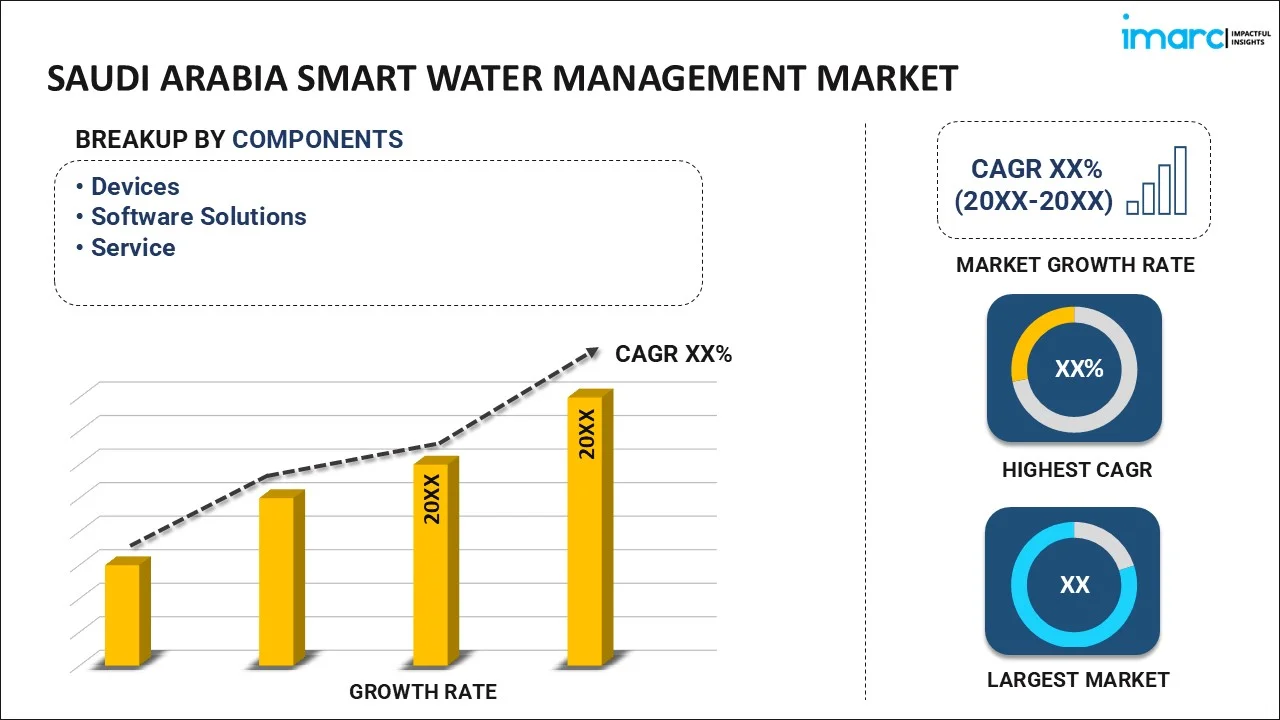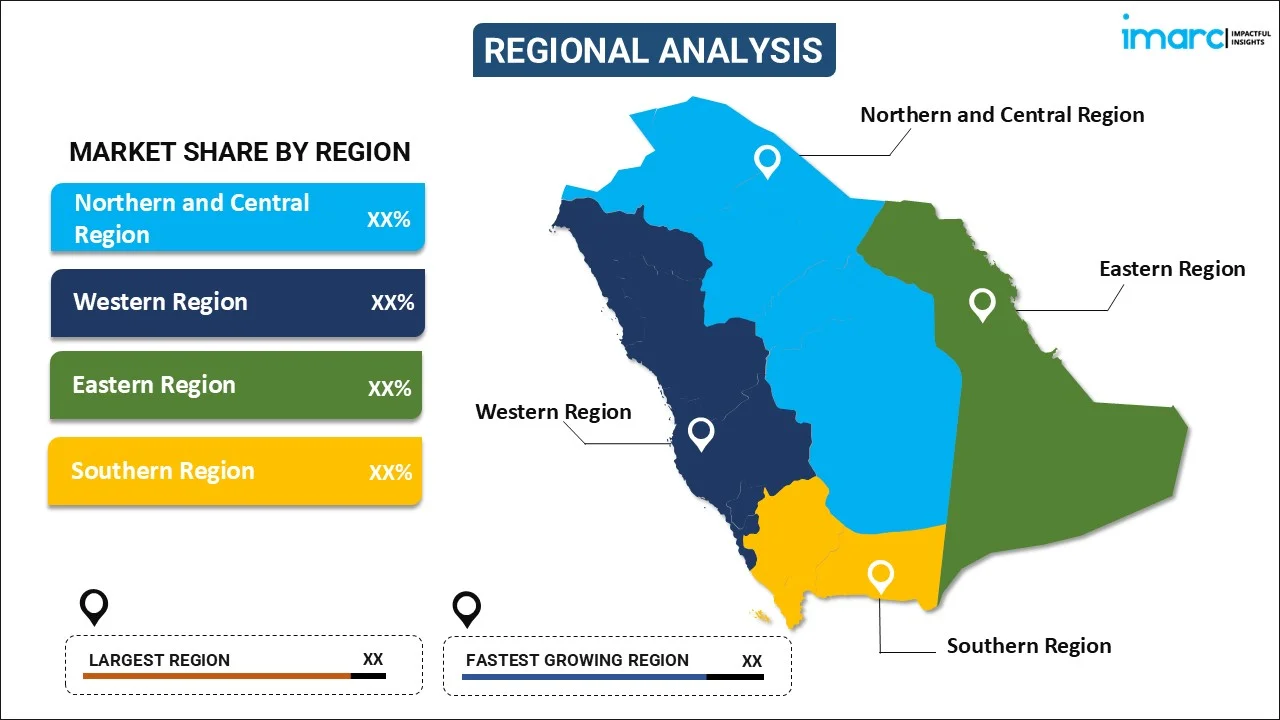
Saudi Arabia Smart Water Management Market Size, Share, Trends and Forecast by Component, Application, and Region, 2025-2033
Saudi Arabia Smart Water Management Market Overview:
The Saudi Arabia smart water management market size reached USD 0.18 Billion in 2024. Looking forward, IMARC Group expects the market to reach USD 0.42 Billion by 2033, exhibiting a growth rate (CAGR) of 9.72% during 2025-2033. The market is propelled by the rising demand for efficient water resource management, increasing government initiatives for water conservation and sustainability, growing adoption of the Internet of Things (IoT) and smart technologies in utilities, and the surging need to address water scarcity issues.
|
Report Attribute
|
Key Statistics
|
|---|---|
|
Base Year
|
2024
|
|
Forecast Years
|
2025-2033
|
|
Historical Years
|
2019-2024
|
| Market Size in 2024 | USD 0.18 Billion |
| Market Forecast in 2033 | USD 0.42 Billion |
| Market Growth Rate (2025-2033) | 9.72% |
Saudi Arabia Smart Water Management Market Trends:
Increasing Demand for Efficient Water Resource Management
The arid climate and limited freshwater resources of Saudi Arabia highlight the need for effective water management, propelling the demand for smart water management solutions. For instance, the nation of Saudi Arabia currently runs 32 desalination facilities along with six under construction which will increase its contribution to 22% of global desalinated water output. With rapid urbanization and population growth, the existing water infrastructure. Moreover, the residential together with agricultural and industrial sectors need growing sustainable solutions to fulfill their different needs. Real-time monitoring systems with leak detection capabilities along with optimized water distribution tools provided by smart water management systems successfully decrease water loss while improving operational efficiency. These solutions generate precise data on water usage and system health, enabling authorities to make informed decisions and focus on areas with the greatest need and impact. Furthermore, Saudi Arabia raises its commitment to sustainability through its Vision 2030 initiative by prioritizing smart water management technology to obtain sustainable efficiency alongside resource preservation and extended water supply security across all sectors of the nation. This is boosting the Saudi Arabia smart water management market share.
Government Initiatives and Investment in Water Conservation
Government initiatives and investments in water conservation are significantly driving the Saudi Arabia smart water management market growth. In the Vision 2030 initiative, the government has set objectives for sustainable development and protection of the environment, with particular emphasis on water conservation. For this vision, the authorities are making active investments in infrastructure initiatives and smart technologies facilitating sustainable water use. For example, in October 2024, The Saudi Water Partnership Company (SWPC) declared its plan to start 18 new water projects worth SAR 45 billion (USD 12 billion) over the next three years to improve water infrastructure across the nation. For example, the National Water Strategy is upgrading solutions to enhance water management and improve supply efficiency. Besides this, fiscal incentives, regulation, and consumer campaigns are motivating the demand for smart water management solutions from consumers, private businesses, and municipalities. These programs show the dedication of the government to long-term sustainability, paving the way for the smart water management market to flourish.
Adoption of IoT and Advanced Technologies in Utilities
The increasing adoption of IoT and other advanced technologies in water utilities is revolutionizing water management practices and driving the market for smart water management in Saudi Arabia. In addition, IoT-enabled meters, sensors, and communication systems are increasingly being applied to water distribution networks to provide insights into water flow, pressure, and quality. Utility providers are also able to monitor infrastructure conditions in real-time, locate leaks or inefficiencies instantly, and react quickly to problems. Besides this, IoT technologies facilitate the automation of water distribution operations, optimizing water allocation according to patterns of demand. While utilities look to make their operations modern, the blending of IoT with big data and artificial intelligence (AI) creates rich sources of insights for decision-making, predictive maintenance, and optimization of resources. Such an increasing application of IoT in the water space is also a complement to the broader national movement towards digitalization. For instance, in February 2025, Wabel Incubator started operations as a partnership between the National Water Company (NWC) and the Saudi Water Innovation Center (SWIC) to develop innovations and support advanced technologies in the water sector. As a result, technology has become the fulcrum for effective water management in Saudi Arabia. These cost-saving, improved service quality, and resource utilization benefits are driving the adoption of IoT and other cutting-edge technologies in the smart water management industry, thus enhancing the Saudi Arabia smart water management market outlook.
Saudi Arabia Smart Water Management Market Segmentation:
IMARC Group provides an analysis of the key trends in each segment of the market, along with forecasts at the region level for 2025-2033. Our report has categorized the market based on component and application.
Component Insights:

- Devices
- Advanced Water Meters
- Meter Read Technology
- Software Solutions
- Asset Management
- Distribution Network Monitoring
- Supervisory Control and Data Acquisition (SCADA)
- Meter Data Management (MDM)
- Advance Analytics
- Others
- Service
- Managed Services
- Professional Service
The report has provided a detailed breakup and analysis of the market based on the component. This includes devices (advanced water meters and meter read technology), software solutions (asset management, distribution network monitoring, supervisory control and data acquisition (SCADA), meter data management (MDM), advance analytics, and others), and service, which consists of (managed services and professional service).
Application Insights:
- Residential
- Commercial and Industrial
A detailed breakup and analysis of the market based on the application have also been provided in the report. This includes residential, and commercial and industrial.
Regional Insights:

- Northern and Central Region
- Western Region
- Eastern Region
- Southern Region
The report has also provided a comprehensive analysis of all the major regional markets, which include Northern and Central Region, Western Region, Eastern Region, and Southern Region.
Competitive Landscape:
The market research report has also provided a comprehensive analysis of the competitive landscape. Competitive analysis such as market structure, key player positioning, top winning strategies, competitive dashboard, and company evaluation quadrant has been covered in the report. Also, detailed profiles of all major companies have been provided.
Saudi Arabia Smart Water Management Market News:
- 30 May 2024: The e-ReWater project received enhanced support from both the Saudi Irrigation Organization (SIO) and the International Water Management Institute (IWMI), with additional funding from Google.org through its artificial intelligence (AI), earth observation data, and remote sensing technologies. The e-ReWater platform expansion received financial backing from Google.org.
- 18 March 2024: The Ministry of Environment, Water, and Agriculture of Saudi Arabia has launched a digital platform for water management supported by geographical information system (GIS). The project aims to develop a smart water digital platform that is in line with global standards of excellence.
Saudi Arabia Smart Water Management Market Report Coverage:
| Report Features | Details |
|---|---|
| Base Year of the Analysis | 2024 |
| Historical Period | 2019-2024 |
| Forecast Period | 2025-2033 |
| Units | Billion USD |
| Scope of the Report | Exploration of Historical Trends and Market Outlook, Industry Catalysts and Challenges, Segment-Wise Historical and Future Market Assessment:
|
| Components Covered |
|
| Applications Covered | Residential, Commercial and Industrial |
| Regions Covered | Northern and Central Region, Western Region, Eastern Region, Southern Region |
| Customization Scope | 10% Free Customization |
| Post-Sale Analyst Support | 10-12 Weeks |
| Delivery Format | PDF and Excel through Email (We can also provide the editable version of the report in PPT/Word format on special request) |
Key Questions Answered in This Report:
- How has the Saudi Arabia smart water management market performed so far and how will it perform in the coming years?
- What is the breakup of the Saudi Arabia smart water management market on the basis of component?
- What is the breakup of the Saudi Arabia smart water management market on the basis of application?
- What is the breakup of the Saudi Arabia smart water management market on the basis of region?
- What are the various stages in the value chain of the Saudi Arabia smart water management market?
- What are the key driving factors and challenges in the Saudi Arabia smart water management?
- What is the structure of the Saudi Arabia smart water management market and who are the key players?
- What is the degree of competition in the Saudi Arabia smart water management market?
Key Benefits for Stakeholders:
- IMARC’s industry report offers a comprehensive quantitative analysis of various market segments, historical and current market trends, market forecasts, and dynamics of the Saudi Arabia smart water management market from 2019-2033.
- The research report provides the latest information on the market drivers, challenges, and opportunities in the Saudi Arabia smart water management market.
- Porter's five forces analysis assist stakeholders in assessing the impact of new entrants, competitive rivalry, supplier power, buyer power, and the threat of substitution. It helps stakeholders to analyze the level of competition within the Saudi Arabia smart water management industry and its attractiveness.
- Competitive landscape allows stakeholders to understand their competitive environment and provides an insight into the current positions of key players in the market.
Need more help?
- Speak to our experienced analysts for insights on the current market scenarios.
- Include additional segments and countries to customize the report as per your requirement.
- Gain an unparalleled competitive advantage in your domain by understanding how to utilize the report and positively impacting your operations and revenue.
- For further assistance, please connect with our analysts.
 Request Customization
Request Customization
 Speak to an Analyst
Speak to an Analyst
 Request Brochure
Request Brochure
 Inquire Before Buying
Inquire Before Buying




.webp)




.webp)












